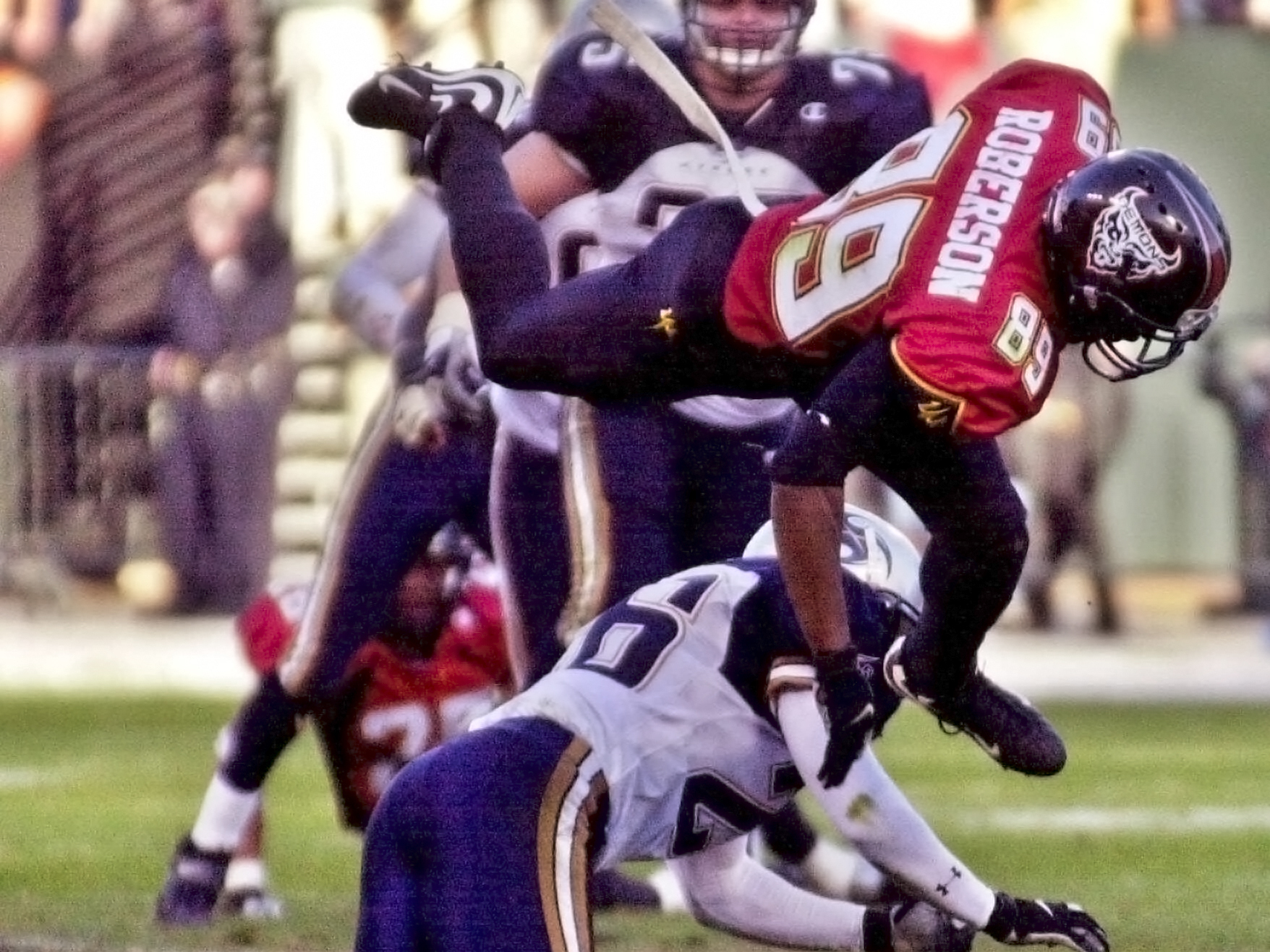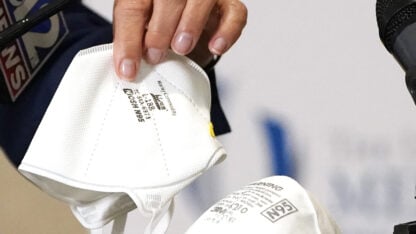The XFL Aims To Capitalize On Spring Football With 9-Point Touchdowns, Other Oddities

The XFL is set for a surprising second life, kicking off games this weekend. In this file photo, San Francisco Demons wide receiver Brian Roberson jumps over Los Angeles Xtreme cornerback Dell McGee during a 2001 game.
Paul Sakuma / AP
The XFL is set for a reboot this weekend nearly two decades after it folded.
Back in 2001, World Wrestling Entertainment CEO Vince McMahon promised a new type of football game: faster, more violent tackles, creative new rules, a brash attitude and scantily clad cheerleaders.
“We welcome you to our brand of football,” McMahon said in his 2001 opening day speech before he growled, “Ladies and gentlemen, this is the XFL.”
Instead of a coin toss, two players sprinted to the ball for possession. Coaches and players were mic’d up and on-field conversations were broadcast live on TV. At halftime, cameras went into the cheerleaders’ locker room. Players used nicknames on the back of their jerseys instead of last names, spawning personalities like “He Hate Me.” The XFL even ushered in regular use of now-ubiquitous aerial footage from Skycams.
The league partnered with NBC and the first games had meteoric ratings. But fans left in droves over sloppy game play and TV ratings plummeted. The league folded after just one season.
The second version in 2020 promises less over-the-top entertainment and better football. XFL officials say they have the resources they need to stick around. McMahon has reportedly promised a half-billion dollar investment. He’s banking on capturing football fans’ attention during the six-month NFL off-season.
Eight teams — Dallas, Houston, Los Angeles, New York, St. Louis, Seattle, Tampa Bay, Fla., and Washington — will kickoff Saturday and Sunday.
The XFL ran a teaser commercial during the Super Bowl that had a faux doctor pitching the league as the antidote to “football withdrawal syndrome.”
The 10-week season runs through most of the spring and ends with a championship game on April 26. Many leagues have attempted to succeed with spring football and so far all have failed.
Here’s more on what the XFL hopes will set it apart from the NFL, and what may, or may not, make it a lasting league.
What’s the draw? Unique rules and personalities.
The XFL promises plenty of wrinkles to make the game interesting:
- A “comeback period”: Often NFL or college teams with the lead at the end of the game will run the ball to run out the clock. In the XFL, the clock will mostly stop after every play within the last two minutes of each half to give trailing teams a chance to catch up and win.
- No extra points: The XFL says the extra-point kicks after a touchdown have become a given, so they added some spice with flag football-style rules. Instead of kicking, teams can choose to run plays from the 10, 5 or 2-yard line. If they get into the end zone, they’ll get 3, 2 or 1 extra point, respectively. The rule, paired with the comeback period, means teams have a better chance of overcoming a deficit and could create more games that remain interesting in the fourth quarter.
- Games under three hours: NFL games last on average about three hours and 12 minutes and have a lot of down time, but the XFL is looking to stuff the same number of plays into less time. It will have a shorter 25-second play clock and the clock will run after incompletions and out-of-bounds plays, instead of stopping as it does in the NFL and NCAA. The XFL is also limiting each team to two timeouts per half, shortening halftime to 10 minutes and eliminating the ability for coaches to challenge plays (though officials can review most plays if they choose).
- Overtime: Gone is “first-team-to-score wins” or games ending in ties. New rules are similar to soccer-style penalty kicks or hockey shootouts. Overtime consists of five rounds where teams will attempt to score from the 5-yard line. The team with the most points at the end wins.
- Multiple forward passes in one play: A quarterback can throw to another player and as long as that second player is behind the line of scrimmage, he can pass forward to another player. The rule could give birth to some innovative trick plays.
The XFL says it will also discourage political gestures from players during games, like former San Francisco 49ers quarterback Colin Kaepernick taking a knee during the National Anthem to protest how police treat people of color.
As to coaches and players, the XFL nabbed some big names, like former Oklahoma Sooners coach Bob Stoops, who will coach the Dallas Renegades, and quarterback Cardale Jones, who won a national championship at Ohio State and will play for the D.C. Defenders. Other former college and NFL players, and those attempting to make the NFL, will round out the rosters.
It’s unclear who could be a breakout personality in the league, similar to Rod Smart (aka “He Hate Me”) in 2001. Renegades wide receiver Jeff Badet has made a social-media splash during practice with his helmet visors based on internet memes, including Spongebob.
Why is it so hard to start a new league?
Several other independent professional football leagues hoping to capitalize on spring football, like the Arena Football League (1987-2008), the United Football League (2009-2012) and the Alliance of American Football (2018), have all folded in the past 20 years.
Most of these leagues cropped up as a way to ride the NFL’s coattails. The NFL is the largest, most profitable sports league in the world, says Darin White, executive director of the Samford University Center for Sports Analytics, which measures “relevance” of different leagues in the sports world.
White knows a bit about the situation. Samford is just outside Birmingham, Ala., where four previous failed football leagues have had a team.
“It’s like any other business,” White said. “Someone believes there’s enough eyeballs on a sport to make it a profitable venture.
“But most (leagues), at the end of the day, don’t have enough capital to survive.”
He says the XFL will have to take a minor league baseball franchise approach: connect with communities, go all-in on “crazy” marketing and make sure fans are engaged.
But fans’ dollars are stretched thin now with so many choices of both live entertainment and streaming at home, White said, that it can be tough to get people hooked on a new option.
“There will be a lot of interest to check out this new shiny cool thing, but the staying power is the key,” White said. “When people go to the game, how is the fan experience? Did they have a good time? Do they enjoy the product on the field?”
Those are key questions as to whether the league can turn football fans into XFL fans. Most pro and college teams trade on years of tradition or deep roots in a community. The XFL will have to build that, he says.
White is withholding judgment until after the XFL’s first season when his sports analytics center can gauge fan growth and engagement.
“It’ll be fun to sit back and watch,” White said. ” Nine leagues have tried it before and all are in the pro-football graveyard.”
One thing is for sure: “It’s a far different sports and media world in 2020 than it was in 2001.”
9(MDAxODM0MDY4MDEyMTY4NDA3MzI3YjkzMw004))








